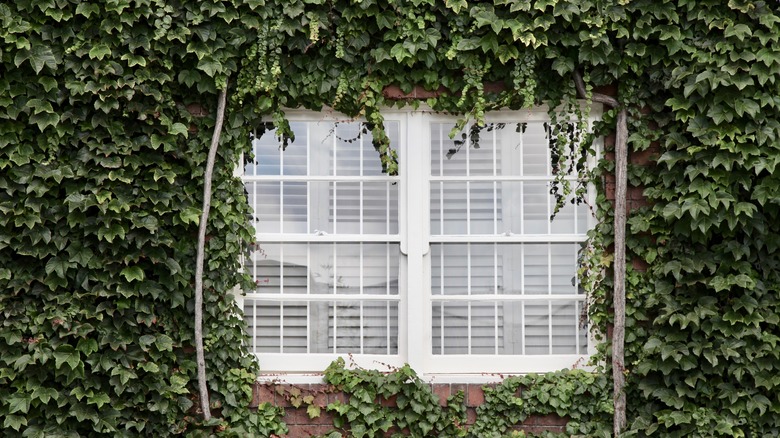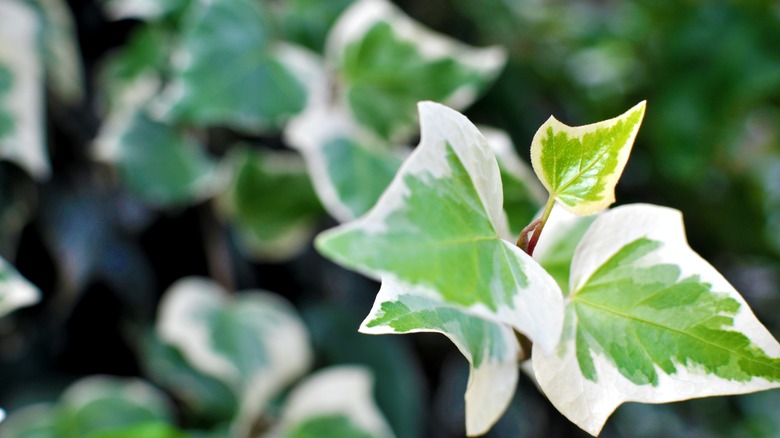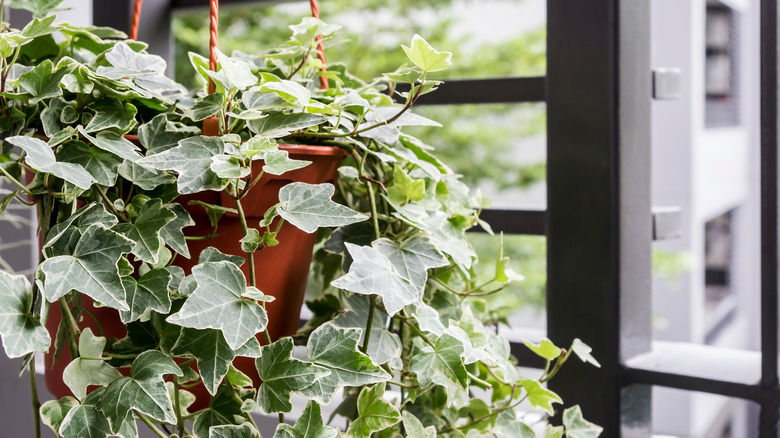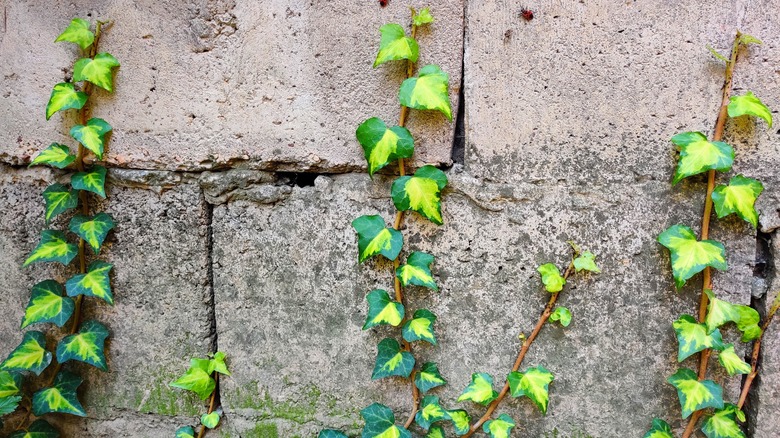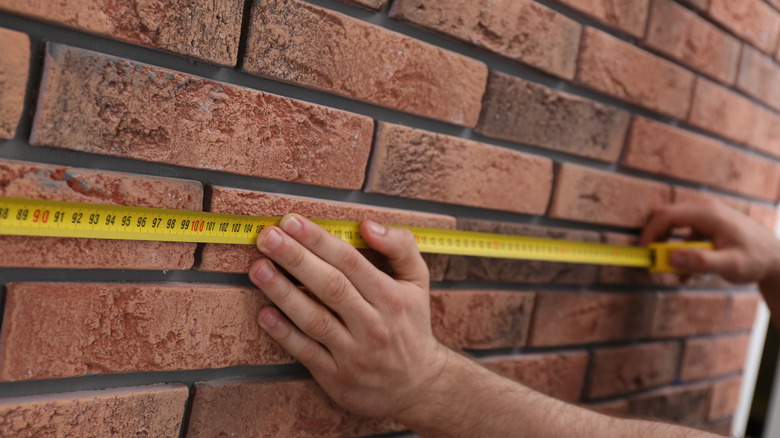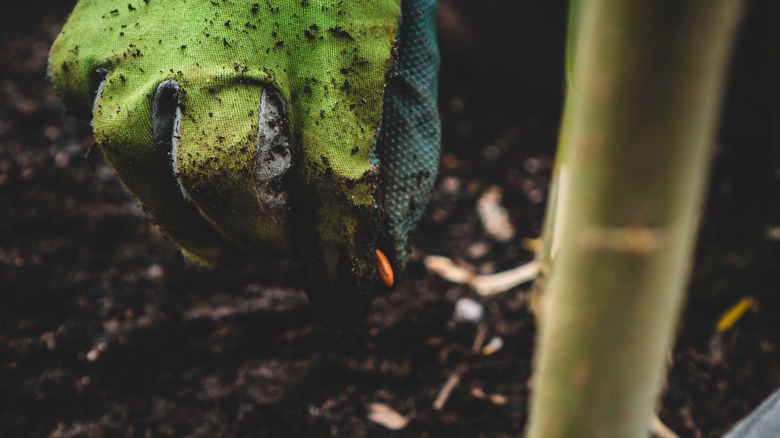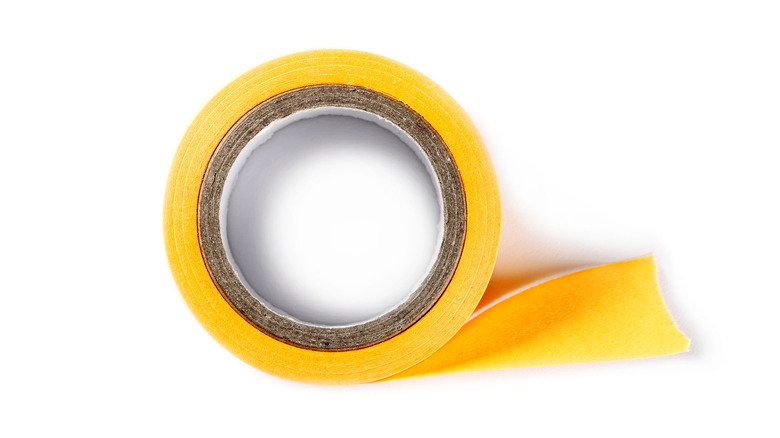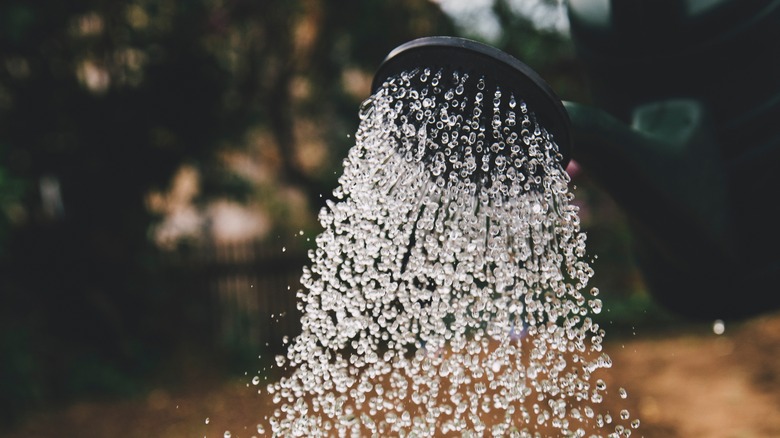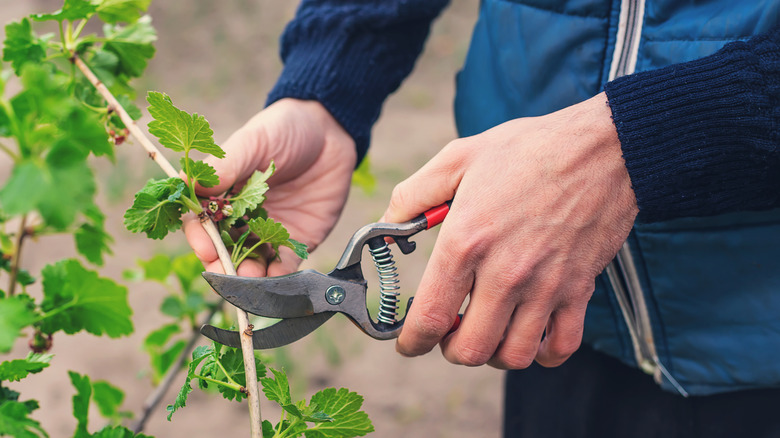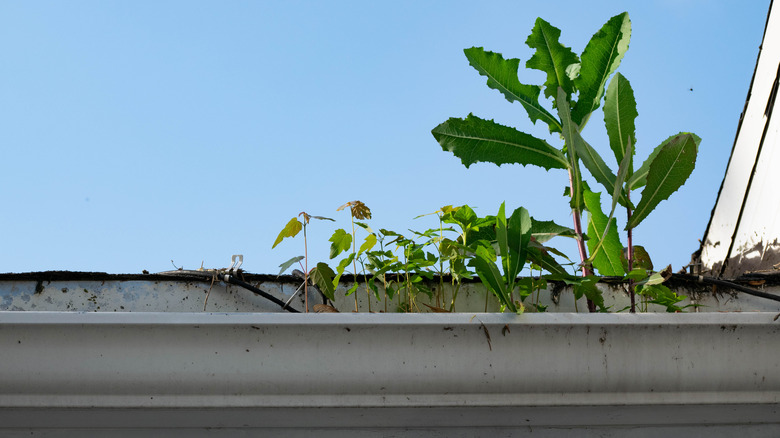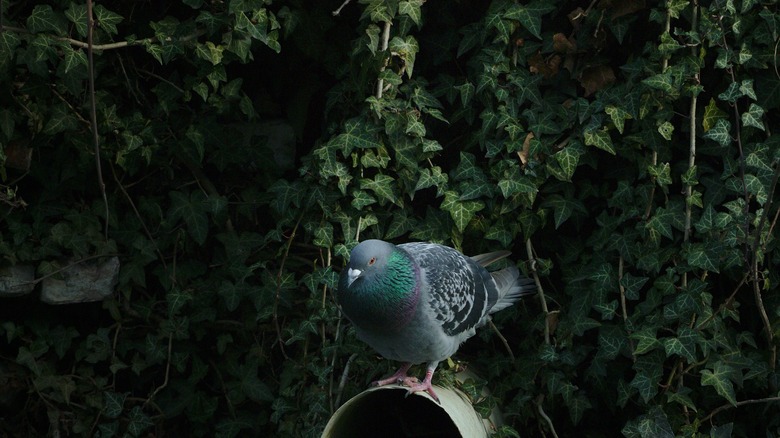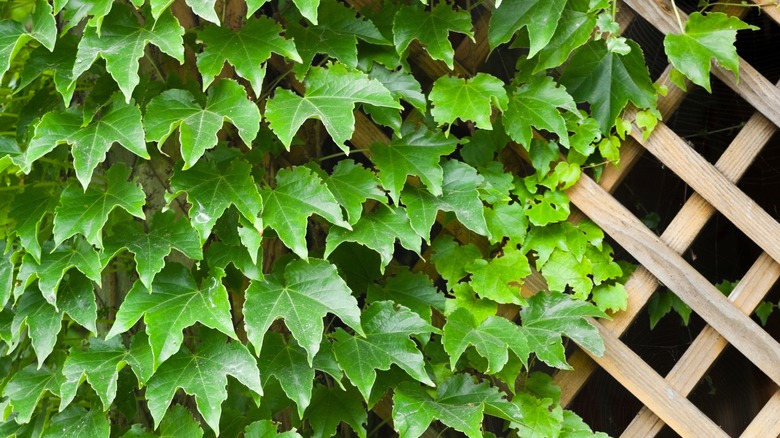How To Grow Ivy Up The Walls Of Your Home
The ivy plant holds a somewhat contentious existence in the gardening and landscaping communities. English ivy, for example, works well as a groundcover for areas too shady to grow anything, but when unkempt can end up depleting nearby plants of sunlight and air. It's true that when untamed, these dark vines can spread fast into unwanted spaces and create a nuisance to get rid of, according to University of Maryland Extension. However, with proper maintenance and expert tactics employed, a small growth of ivy plants can turn into a lush, green curtain of leaves and vines along or on top of an exterior wall.
The beauty of ivy-covered walls stir up images of historic castles or buildings of regal importance. While these walls are also aesthetically beautiful, there are quite a few benefits to growing ivy on up the walls of a house. Boston Ivy, for example, can act almost like a sun screen for a home, according to Boyd Nursery Company, reducing temperatures during the hottest months of the year and ultimately saving money on energy. Different strains of ivy can also display different colors and shades, from white spots to seasonal reds and oranges during the autumn season.
For anyone looking to spruce up their exterior with these fast-growing plants, there are ways you can go about making choices best for the plant and your home.
Explore all varieties of ivy plant
Not all ivies are created equal, and some species are better equipped to grow on your home's exterior than others. There are a few species to look out for and investigate before choosing one for the side of your home.
Boston Ivy, though not technically an ivy, is the most common plant to grow on buildings, according to Plan Your Patch; its name in fact comes from its reputation of decorating the outside of ivy league universities. It has smaller leaves, grows fast, and is self-clinging, meaning a support structure isn't needed to keep it attached to walls. Virginia Creeper is another excellent variant ivy for being one of the most versatile, according to Lawrence Park, not only for its ability to withstand all types of sunlight and soil, but also because it requires almost no maintenance after establishing roots.
English Ivy is also a possibility as it also performs well under many types of sun, however it takes longer to establish and has more definite needs for soil. Both Boston and Virginia creeper thrive in loamy, moist soil, though Virginia creeper might need added fertilizer during its first year after planting. Boston ivy also has one leaf with 3 singular points, while Virginia has 5 leaves connected at one central point. Both change colors with seasonal change, while English Ivy only showcases yellow-greenish flowers, according to GardenBeast. No matter the variety you decide on, each will have a lovely green look.
Avoid invasive species
Ivy is "invasive" by nature because of its growth patterns, and characteristics that many species of ivy possess can make these plants seem like a potential nuisance. When planning to create a green ivy wall on your home's exterior, knowing what type of ivy you want is half the battle. Avoiding certain kinds of ivy is the best way to make the most out of the plant and protect your home against more trouble down the road.
English ivy is easily the most invasive species for a variety of reasons that make it a dangerous inclusion to your outdoor living wall. This particular species is known as an aggressive invader and threatens everything from ground-covering plants to both sick and healthy trees, according to Invasive Plant Atlas. Its vines grow thickly, easily covering branches and plants, which inhibits photosynthesis and their ability to essentially breathe. This pattern also prevents new saplings from growing, according to the California Department of Fish and Wildlife, particularly for trees that shed leaves seasonally. Its growth can also kill local plant life, which affects local wildlife that depends on those plants.
This plant harms several types of victims, as the leaves and fruit of English ivy are toxic to humans and livestock. An effort to get rid of ivy can be expensive due to the plant's natural invasiveness and sticky roots that can infiltrate other yards or otherwise healthy natural habitats. This type should be avoided at all costs.
Grow ivy on masonry, as long as it's not cracked
The decision of which wall to grow ivy onto is just as important as choosing a plant species. According to Today's Homeowner, the structural integrity of the wall itself will affect a few things, including how well the ivy takes to the structure itself and if the wall can sustain the weight of the vines.
Structures that are most susceptible to the negative aspects of an ivy wall include weakened or older brick buildings, dry-stacked walls, stucco, and wooden walls and fences. Anywhere there are cracks, crumbling sections or openings in joints are perfect places for ivy to grow into and ultimately widen and/or allow for moisture to penetrate. This only causes further damage and can hinder progress on the growth of the ivy into the right shape. For stucco and other heavily-painted walls, ivy can attach and, if it becomes too heavy, can pull pieces of the wall down completely.
These problems mostly only affect older buildings and properties and ones that also are in some state of disrepair, according to the Royal Horticultural Society. Structures with sound brickwork and solid masonry walls are better choices for growing ivy. On the upside, these plants can also be used to cover walls with unappealing features, including a bad paint job.
Consider height and sun accessibility
To grow an ivy wall, one should also take into account the height of the wall itself. Depending on the species of ivy you choose, certain varieties might overwhelm the space, or underwhelm in certain situations.
The more classic choice of Boston Ivy is known to grow between 30 to 60 feet, according to Clemson University, creating a beautiful wall of thick, dark green leaves fairly quickly. As a well-behaved climber, according to Gardenista, "quickly" can mean that a full wall could take five or more years to grow, in order for the plant to reach full maturity. With this height in mind, it is good to choose a wall that has enough space so as not to be overwhelmed in this amount of plant matter. You'll also need full access to the wall to ensure that proper trimming and maintenance can be done on all sides.
In terms of accessibility to sunlight, this wall, no matter the height, should be facing in a direction that will allow the ivy to have enough sunlight to support its growth. Different species have differing needs when it comes to the amount of light. For example, Boston Ivy prefers moist soils and partial shade to full sun, while Virginia Creeper can succeed in drier soils and warmer temperatures as well as more sun (via Clemson University).
Aim for spring or fall for planting, with ample space between each
Starting plants inside for transferring later can often save finicky or highly-susceptible plants from meeting an early end. Whether you're propagating your ivy from an indoor potted plant or starting fresh outside, aim to plant during months with balanced light and watering. Spring and fall are ideal, and when matched with proper spacing, can lead to optimal growth. However, keep in mind that certain varieties do better at different times and through different methods.
Virginia creeper is best planted during fall and spring, and can be started from a seeded pot at any time, according to Gardener's World. Planting at this time helps the plant to establish strong roots when the soil is still moist and warm. Boston ivy, on the other hand, needs a more seasonal approach to harvesting/planting. According to Garden Guides, seeds created by this species can be harvested in late fall and kept in a cold frame greenhouse for about six weeks before being transferred to a pot to grow throughout the winter. These can then be planted outside in late spring or after the last frost.
When planting English ivy, dig each hole twice as wide as the plant's root, spacing the plants 6 inches apart. Be sure to give your plants ample space to grow once transferred outside, being sure to plant at least a foot away from the wall, according to Fantastic Gardeners.
Use trellises or wire to train the plant's growth
The science behind how certain plants climb exists in their structures. Species like Boston ivy and Virginia creeper use what is known as adhesive pads or aerial roots, according to Great Garden Plants, which are touch-sensitive suction cups that can help the plant stick to vertical surfaces as it continues to grow. Support for these vines is needed as sometimes gravity is too powerful and, if not properly supported, can result in the vines growing along the ground.
To further help your plant's growth, avid gardeners have discovered methods of training the vines to follow a skyward path, including trellises, wire fencing, or poles. Once they're established, vines will naturally start clinging to the wall on their own, but for the first few years, they'll need the help of a trellis, poles, or even wire strung back and forth across the area you'd like them to grow on. This helps get the vines trained to go where you want them, and once the vine is mature, you won't see much of this initial support system at all. The vines can be attached to the structure with garden twine, hook and loop strips, or plastic garden tape.
Maintain regular watering until the ivy is established
Gardeners have a saying about planting aggressive groundcovers like ivy, according to The Los Angeles Daily News: "The first year it sleeps, the second year it creeps and the third year it leaps." This saying dictates that when planting ivy against a wall, its progress might seem slow or nonexistent at first, but it's important to trust, and participate, in the process as the ivy grows its roots during its first year.
Like most new sprouting plants, water plays a key role in development in growing these roots. Keep the ivy watered regularly, not soggy but adequately wet even between watering. This will also depend on the time of year planted and how much sun the plants can access from their location. Luckily, watering by hand is only required for the first season after planting, according to Fantastic Gardeners, as most ivy species will have grown strong roots that stretch deep enough into the ground to feed without manual watering.
Be mindful and intentional with pruning
Pruning ivy correctly is important and can aid in the plant's growth in more ways than you'd think, both in terms of keeping the plant looking good, and in keeping it healthy. Finding the right time to prune is important, noted by the Royal Horticultural Society, as it can affect how the plant flowers the next season it's meant to. This could lead to its seed harvesting timeline to be disjointed for a year, increasing how long it will take to create the ivy wall in the first place.
The Society recommends pruning normal growing ivy in the mid-spring; for any overgrowth or a large mass of untamed ivy, these should be pruned heavily early spring so as to give the vines time to sprout new growth during the season. After the vines are well established and your wall is well on its way, pruning can be done once a year.
Keep vines out of gutters and off the roof
As we've noted, pruning keeps ivy growing in the proper direction up and across the wall you're looking to decorate. There are other areas of a home, however, that if compromised by vines can be much more difficult to remove.
To prevent needing to remove ivy, be sure to manage its growth around and near gutters and roofing. According to ProClean People, ivy removal from gutters is probably the number one reason professionals are called in to remove plant life from gutters. These structures are perfect places for ivy to nestle and cause blockages. If caught in or wrapped around gutters, the ivy's removal and potential damage inflicted can stop your ivy wall journey short.
Apart from ivy grown on walls, it's also best to look out for ivy growing on trees, as noted by Grayson's Gutter Cleaning. On their own, trees are bound to create blockages from above or far away, but with ivy, these added vines can damage roofing tiles and gutters. Annual pruning will help keep the ivy in check, but to keep the growth further contained make sure to keep gutters and roofs clear.
Inspect vines for critters, good and bad ones
One of the great reasons that ivy exists so beautifully on walls is its ability to garner moisture and keep heat inside the walls it protects. However, with this layer of protection these vines also create perfect hiding spots for pests, both small and large.
Many insects are attracted to the flowers ivy grows during the spring, according to The Wildlife Trusts — some species are beneficial or beautiful, including honeybees and red admiral butterflies, while the flowers' nectar also attract more harmful pests like hornets. Larger animals, such as birds and bats, also find the tangled vines of ivy perfect places to nest or roost, so be sure to keep an eye out for budding nests and removing carefully.
Moisture especially attracts pretty much everyone's least favorite insect: mosquitos. Ivy's thick, large vines are ideal places for mosquitos to frequent, according to The North Carolina Native Plant Society. Even smaller and more detrimental to the plant, however, are diseases that can flourish if ivy is not cared for properly. Leaf spots, according to the American Ivy Society, are caused by fungus or bacteria, while other smaller pests like aphids secrete sap that causes black fungus to grow. Ways to prevent bug infestations, including spider mites, mealy bugs or aphids, is to wash and wipe leaves with alcohol, remove dead leaves and keep its water intake regulated, as too much or too little can upset its balance.
Start with trial-sized projects if you're unsure
If the prospect of growing ivy against your home seems daunting, a great way to dip the proverbial toe in is to try against something smaller. A great starter project, according to The Zhush, can be growing ivy along a trellis to get a feel for the practice and test how ivy behaves during its growing season, before committing to a full wall. To garner the best results, Brainy.Garden on YouTube recommends planting the trellis in a mixture of well-rotted manure and sand, to be both well-draining and rich with nutrients.
Another potential idea is to start on a smaller structure that is house like, mainly a child's outdoor playhouse or even a backyard shed, as long as the structure is well-kept and its walls and joints are undamaged. This Old House notes that though there are many types of garden sheds, both premade or DIY-based, six feet is the average height of most sheds, a highly attainable height for ivy plants to grow to. If either or all projects go well, this should give you enough experience to move on to a full-scale home.
